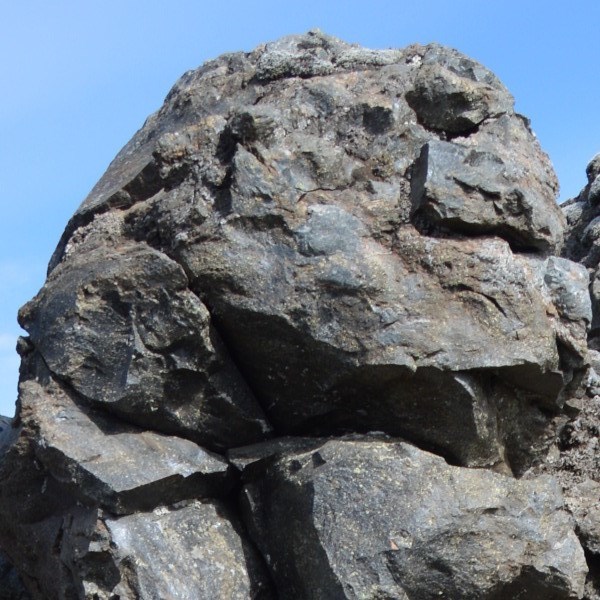U Liotru EarthCache
-
Difficulty:
-

-
Terrain:
-

Size:  (other)
(other)
Please note Use of geocaching.com services is subject to the terms and conditions
in our disclaimer.

[ITA]
U Liotru è l'emblema della città di Catania ed è il nome comunemente dato alla statua di basalto nero raffigurante un elefante che compone la fontana collocata al centro della Piazza del Duomo di Catania.
L'opera è stata realizzata nell'ambito della ricostruzione della città dopo il terremoto dell'11 gennaio 1693. Essa è costituita da tre elementi di rocce differenti. Il basamento è formato da un piedistallo di marmo bianco situato al centro della vasca della fontana, anch'essa in marmo. Al di sopra si trova la statua dell'elefante in basalto nero, sulla cui schiena si erge un obelisco in granito.
Il basalto è una roccia effusiva di origine vulcanica di colore grigio scuro o nero. Viene prodotto dal magma solidificato velocemente all'aria o in acqua, per questo è la principale roccia costituente la parte superiore della crosta oceanica.
La parola basalto deriva dal tardo latino "basaltes", una riscrittura della parola "basanites", che significa "roccia molto dura" e in effetti alcune forme di basalto sono molto resistenti.
La forma e la struttura del basalto possono indicarci come e dove è stato eruttato il magma che lo ha generato.
a) Il basalto eruttato in condizioni di aria aperta (condizioni subaeree) può formare strutture vescicolate, ossia con un aspetto "schiumoso" ed una bassa densità. Si può presentare di colore rosso, a causa dell'ossidazione dei minerali ricchi di ferro.
b) Durante il raffreddamento di una grossa colata lavica si formano fratture. Se la colata tende a raffreddarsi rapidamente intervengono delle forze che tenderanno a farla contrarre in modo significativo. Mentre verticalmente le tensioni tendono a compensarsi, orizzontalmente la roccia non riesce a smaltirle e tende a fratturarsi dando il tipico aspetto colonnare esagonale (basalto colonnare), il cui diametro dipende principalmente dalla velocità di raffreddamento (maggiore velocità causa un minor diametro). Un esempio sono i basalti colonnari delle Gole dell'Alcantara.
c) Quando infine un basalto è eruttato in condizioni subacquee (ad esempio nelle dorsali oceaniche) l'acqua raffredderà rapidamente la superficie della lava e causerà la formazione delle tipiche strutture a "cuscino" (pillow). I pillow tipicamente hanno un interno a grana molto fine e una crosta vetrificata, presentano inoltre una fratturazione radiale. Le loro dimensioni variano da circa 10 cm fino a qualche metro.
Per loggare il cache rispondi a queste domande inviando un messaggio all'owner attraverso Geocaching Messenger o via email.
1) Secondo te che tipo di basalto è stato utilizzato per scolpire il Liotru? (a, b oppure c)
2) Motiva la tua scelta.
3) Quali parti dell'elefante ha la superficie più porosa?
4) Le rocce che costituiscono il piedistallo e l'obelisco hanno un'origine completamente diversa dal basalto dell'elefante. Confornta le differenze.
[ENG]
The Liotru is the emblem of the city of Catania, it is the name commonly given to the black basalt statue which depicts an elephant embedded in the fountain located in the middle of the Piazza del Duomo in Catania.
The fountain was built after the earthquake of January 11, 1693. It consists of three different rock elements. The base is formed by a white marble pedestal located in the center of the fountain's basin, also in marble. Above there is the statue of the elephant in black basalt, on whose back stands a granite obelisk.
Basalt is an effusive volcanic rock of dark gray or black color. It is produced from magma quickly solidified in the air or in water. Basalt is the main rock constituting the upper part of the oceanic crust.
The word basalt comes from the late Latin "basaltes", a rewrite of the word "basanites", which means "very hard rock" and in fact some forms of basalt are very resistant.
The shape and structure of the basalt can indicate how and where the magma that generated it was erupted.
a) Basalt erupted in open air conditions (subaerial conditions) can form vesicular structures, i.e. with a "frothy" appearance and low density. It may be red in color due to the oxidation of iron-rich minerals.
b) During the cooling of a large lava flow, fractures form. If the flow cools down rapidly, forces increase significantly. While tensions can compensate vertically without fractures, in the horizontal direction the rock cracks giving the typical hexagonal columnar aspect (columnar basalt), whose diameter mainly depends on the cooling speed (higher speed causes a smaller diameter). An example is the columnar basalts of the Alcantara Gorges.
c) Finally, when basalt erupts underwater or flow into the sea (for example in oceanic ridges) the water rapidly cools the lava surface and cause the formation of the typical "pillow" structures. Pillows typically have a very fine-grained interior and a vitrified crust, they also have radial fracturing. Their dimensions vary from about 10 cm to a few meters.
To log the cache, answer these questions by sending a message to the owner via Geocaching Messenger or via email.
1) In your opinion, what kind of basalt was used to sculpt the Liotru? (a, b or c)
2) Motivate your choice.
3) Which parts of the elephant are more porous?
4) The rocks that make up the pedestal and the obelisk have a completely different origin from the basalt of the elephant. Compare the differences.
Esempi/Examples

a) Balsalto rosso/Red basalt

b) Balsalto colonnare/Columnar basalt

c) Balsalto a cuscino/Pillow basalt
Additional Hints
(No hints available.)